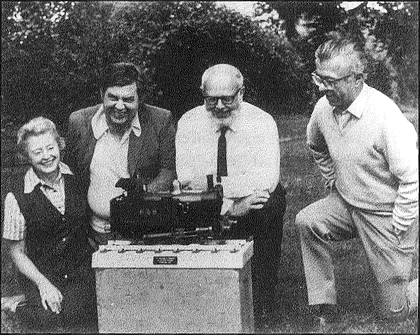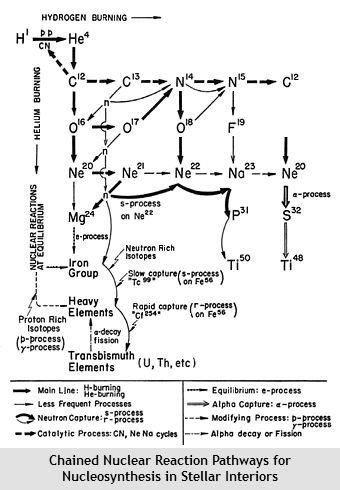



 M. Burbidge is probably most thought of for being the lead author of
a famous, landmark, 108 page paper in Reviews of Modern Physics
in Oct, 1957 -- Burbidge, Burbidge, Fowler, & Hoyle, usually
referred to as B2FH -- which laid out the details of the
chained nuclear reactions for nucleosynthesis in stellar interiors,
which is the basis for our modern understanding of stellar evolution,
how the elements heavier than hydrogen and helium in the periodic
table (known collectively as "metals" in astronomy) are created, and
the processes leading up to novae and supernovae. All of these in
turn form the basis for our understanding of the chemical evolution
of galaxies, their increase in "metallicity" over time.
M. Burbidge is probably most thought of for being the lead author of
a famous, landmark, 108 page paper in Reviews of Modern Physics
in Oct, 1957 -- Burbidge, Burbidge, Fowler, & Hoyle, usually
referred to as B2FH -- which laid out the details of the
chained nuclear reactions for nucleosynthesis in stellar interiors,
which is the basis for our modern understanding of stellar evolution,
how the elements heavier than hydrogen and helium in the periodic
table (known collectively as "metals" in astronomy) are created, and
the processes leading up to novae and supernovae. All of these in
turn form the basis for our understanding of the chemical evolution
of galaxies, their increase in "metallicity" over time.

A 7th scientist not with the others, Norman Lockyer (see
May 17), first sees helium in the
Sun's spectrum and gives it its name. Jules Janssen also saw the
unknown line in the spectrum but didn't go out on the limb of
proposing it to be due to an unknown element.
Helium was otherwise unknown on earth until 1895, when it was
found in the uranium ore cleveite (named after one of the Swedish
chemists involved) where it is a radiogenic product, i.e., made
by the radioactive decay of the uranium.
The helium visible in the sun, by contrast, is mostly primordial,
with only a tiny fraction having been made in the core by the fusion
of hydrogen into helium (the sun's power source), there being no way
for it to get from the core up to the surface during the sun's
lifetime as a normal star; an even smaller fraction is radiogenic.


©2002-2024, Chris Wetherill. All rights reserved. Display here does NOT constitute or imply permission to copy, republish, or redistribute my work in any manner for any purpose without prior written permission.

[ Back to July || On to September ]
[ To: History Directory || Main VISNS page ]